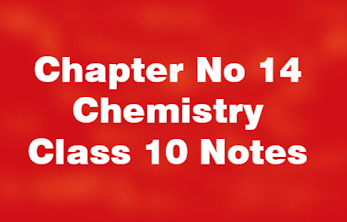Chemistry Class 10 Notes CHAPTER NO.14
ENVIRONMENTAL CHEMISTRY I: Atmosphere
Q.1: Describe the layers of the environment.
Ans: Environment
consists of four layers which are:
i.
Lithosphere or Geosphere ii. Hydrosphere
iii.
Biosphere iv.
Atmosphere
i.
Lithosphere:
The lithosphere consists of the rocky crust of the earth,
soil minerals, and organic matter.
ii.
Hydrosphere:
Hydrosphere consists of all water bodies like
oceans, lakes, rivers, streams,
springs, glaciers, and underground water.
iii.
Biosphere:
The biosphere
is the region of the earth that is capable to support life. The biosphere consists of plants animals
and all the things to support them.
iv.
Atmosphere:
The layers of gases surrounding
the earth are called the atmosphere. It contains gases like oxygen, nitrogen, carbon
dioxide, and noble gases.
Q.2: What is environmental chemistry?
Ans: Environmental chemistry (or) Ecology;
"The branch of chemistry which deals with
the study of the environment and the
changes occurring in it is called environmental chemistry." OR "The branch of chemistry which deals
with the study of interactions of chemical substances/processes with the environment and
their effects on it are called
environmental chemistry."
Air pollution and water pollution
are the two main areas studied in this branch of chemistry.
Q.3:
Define the Atmosphere? Explain the composition and layers of the atmosphere.
Ans: Atmosphere:
"A thick protective blanket of air/gases
around the earth which helps to
sustain life is called the atmosphere."
1. Composition of atmosphere:
The
composition of the atmosphere is given below:
i. Major constituents:
The major constituents of the atmosphere are
nitrogen (78.1% by volume)
and oxygen (20.9% by volume)
ii. Minor constituents:
The
minor constituents of the atmosphere are:
i. carbon dioxide about 0.03%
ii. noble gases(about 1%) i.e. helium,
neon, argon, krypton, xenon)
iii.
Varying
amount of water vapors and some other gases like methane, carbon monoxide, etc.
iii. Mass:
The mass of the atmosphere is about 4.5 to 5 x1015
metric tones.
iv.
Density:
The density of the atmosphere is
0.0013g/cm3, which gradually decreases with altitude.
v.Temperature and pressure:
The temperature and pressure of the atmosphere
change with the increase in
altitude. The temperature ranges from -92 °C to 1200 °C.
The pressure of the atmosphere at sea level
is late but at high altitude, about 100Km, above sea level it decreases to 3x10-7atm.


